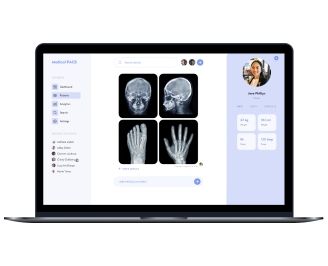Helping a medical imaging company drive user satisfaction
Find out how our elaborate consulting approach helped a teleradiology company’s development team optimize their workflow, quickly process user feedback, and increase customer and employee satisfaction.
-
industry
Healthcare
-
Country
USA
-
Team size
10+
-
Implementation
6 months
About the client
Medical PACS is an American teleradiology and telemedicine platform that allows private hospitals and clinics to upload, store, and download medical images such as radiograms and ultrasound images from secure cloud storage. Initially, the company focused only on teleradiology, but after implementing additional telemedicine functionality, Medical PACS started actively growing alongside their user base.

Business context
At first, the company requested Yalantis to assist their in-house team in coping with several critical issues. They were posed by a rapidly growing user base and consequently the difficulty of navigating lots of patients’ records:
- The user satisfaction rate had dropped to 55% as the team spent weeks processing user feedback.
- The team’s backlog was crowded with new tasks, so the team couldn’t react quickly to requests for fixes, improvements, and new features.
- During an in-depth analysis of the client’s business condition, we discovered additional organizational, operational, and technical issues we needed to solve.
Solution overview
-
Investigating the client’s organizational level involved studying the company’s structure and defining key decision-makers as well as the roles and responsibilities of each team member. At the operational level, we explored relations among team members involved in the project and their project management rules and activities. And at the technical level, we studied the client’s actual software development approach, technology stack, and services used.
-
After a thorough audit of the processes at each level, we proposed solutions to optimize workflows at all levels.
Auditing organizational processes
Yalantis experts revealed hidden bottlenecks in how the client’s business operates, the team composition, as well as development and communication processes. We provided the following actionable insights and solutions:
- A business flowchart to increase workflow visibility and prepare the ground for improvements at the operational and technical levels
- An overview of business decisions that led to low user satisfaction and slow software delivery
- A range of improvements to the organizational structure and team composition to increase project efficiency
- A detailed implementation roadmap for these improvements
-
Resolving operational issues
During operational level analysis, we identified five significant operational issues:
- The same channel (the support form in the platform interface) was used for collecting user feedback and getting new feature requests.
- The team responded to user feedback and implemented new functionality only with new releases.
- The product owner could request implementation of new features in the middle of development sprints, affecting sprint deadlines and commitments to end users.
- All team members developing different parts of the product were present at each other’s meetings.
- With broken commitments, aggressive deadlines, and plenty of meetings, the client’s development team was demotivated and underperforming.
To efficiently solve those issues, we engaged:
- Stakeholder management to ensure the clarity and completeness of requirements
- Parallel development for increased velocity
- A requirements architecture map to visualize the impact of each change and requirement on the overall software solution
-
Troubleshooting technical bottlenecks
We identified that the company needed to optimize testing procedures and properly establish integration and delivery processes. Our solutions included:
- Implementing continuous integration and delivery for parallel development
- Speeding up the implementation of urgent fixes and feature requests by adding multiple servers to the environment architecture
- Increasing testing speed with a custom automation testing framework
Value delivered
Our commitment to providing the highest value to the client’s business operations as well as the client’s willingness to change and implement new ways of work led to the following successful outcomes.
Before:
-
It took weeks to process user feedback and implement bug fixes and feature requests.
-
A customer satisfaction survey showed that only 55% of users were enjoying the platform.
-
The company’s whole development team was involved in all meetings and sessions, losing time on unnecessary activities.
-
The employee satisfaction index (ESI) was 43%, and developers felt demotivated.
After:
-
It takes 2 days to process high-priority tickets from end users and 1 day for urgent bug fixes and updates.
-
A new customer satisfaction survey showed an 87% satisfaction rate.
-
Thanks to parallel development, team members spend much less time on synchronization meetings.
-
With improved collaboration, adherence to the Agile methodology, and less time spent on meetings, the team’s satisfaction has grown to 85%.
Optimize your healthcare workflow with professional IT consulting
Get an assessment of your current business operations and define the root causes of daily disruptions that hinder your business evolution.
More projects
-
IT consulting for a mental health company
Business and design consulting for integrating a practice management system with an EHR system
-
BI for operational efficiency of hospitals
BI consulting services for a US-based hospital
-
Medical IoT solution
A telehealth system enhanced with a remote patient monitoring module and IoT technologies


